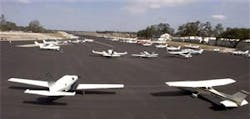Number of Fly-In Communities Nationwide Increasing Yearly
HOLLAND, Wis. (AP) -- If Paul Schneider wants to hit the links 130 miles north of his home, he doesn't have to worry about distance or road conditions.
The 64-year-old can walk 40 feet out of his house into his oversized garage, fire up his single-engine four-seater Cessna 172, pull it onto the runway next to his house and let his wings take him to an airport near the course.
''I think that's one of the reasons people live on an air park,'' he said. ''Here you pull it out of the your hangar, you leave, you come back, you pull it into your hangar and you are done.''
He's one of a growing number of pilots moving to residential air parks, or fly-in communities, to be closer to their planes, according to Dave Sclair, founder and organizer of Living with Your Plane Association.
The limited amount and increasing cost of airport hangar space are driving the growth, said Sclair, who is based in Tacoma, Wash.
''If I am spending $1,000 a month renting, why don't I buy a piece of property with a home on it and put that money into my home,'' Sclair said. ''It's strictly driven by finance, economics and a lot of convenience, too, and a pleasant place to live.''
Pilots can also get into the sky easier with a newly created sport pilot license, which has lower training requirements than a private pilot's license. That may also encourage some pilots back to the hobby and lure people to air parks, he said.
Sclair doesn't have exact numbers nationwide but said about 500 air parks have registered with him and they have two to 1,300 homes each. Florida has the most air parks, along with Washington, California and Texas.
Residents are usually well-established professionals and between 45- and 55-years-old, according to association surveys.
Schneider lives in the 26-year-old Holland Air Park, one of 10 in Wisconsin. He and his wife moved there six years ago from nearby La Crosse. He loves the camaraderie of his neighbors, many of whom share a love of flying. They take supper or breakfast outings together. They help each other build and repair planes. They share tools and knowledge.
''You know pretty much what everyone else is doing, and Friday and Saturday nights, a lot of us get together and go out to eat,'' Schneider said. ''If you lived in town, you might not talk to your own neighbor for six months at a time.''
Out his back windows, he can watch planes take off from the 3,000-foot-long runway and see the backside of a row of houses across the runway. The houses range from $200,000 to $500,000, he said.
Schneider said he has become accustomed to the buzz of planes.
''If my head's in the paper, I don't even turn to see who left,'' he said.
There are about 21 families, each with one or two acres, and 28 planes. Each person has key to the fuel pump, which is computerized and bills individual pilots. Each person also pays a yearly maintenance fee.
The neighborhood, which is patrolled regularly by law enforcement and neighbors' eyes, even has a memorial for residents who have died.
Schneider expects demand for air parks to increase because many baby-boomer pilots will soon retire.
One of the fancier air parks is Spruce Creek Fly-in, with 1,200 residents and 600 hangars in Daytona Beach, Fla.
The 1,400-acre walled community - once the home to actor and pilot John Travolta - has security guards, a golf course, tennis courts, its own restaurants and a plane maintenance facility. The landing strip is owned by the residents who chip in for the maintenance.
Carlos Bravo, 45, has lived near the main airstrip for about six years.
''I wanted to be able to park the airplane behind my house,'' said Bravo, a semiretired management consultant. ''It's like a different world for people not familiar with this. They can't imagine there is such a lifestyle.''
Bravo, who has a 1940 Boeing Stearman and a Socata Trinidad, looked at 15 communities across the nation before he moved from Chicago.
Air parks are a good investment, with property values 10 percent to 25 percent higher than comparable property, Sclair said. But it takes longer to sell air park property because only certain people want to live on an airstrip, Sclair said.
In Cornell, Wis., John ''Jack'' Bresina, 53, is developing a residential air park - Cornell Aero Works LLC - after buying a municipal airport three years ago.
He said interested buyers want to get out of the metropolitan area.
''Typically, it's an empty nester who wants to move out of the city and into the country and is also interested in aviation,'' he said.
There are very few accidents involving air parks, Sclair said. Hoskins Field in Olympia, Wash., has had at least two accidents since its 1960 start.
Lori Hoskins, 61, whose late husband started the airstrip, said one accident killed her stepdaughter and another killed her son-in-law.
She no longer lives on the strip - the yard upkeep was too much - but the accidents never forced her off.
''You have your own private entertainment all the time,'' she said.
